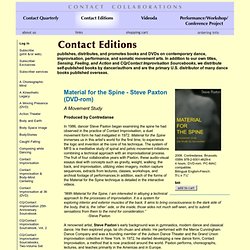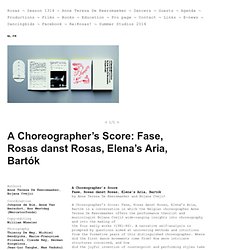

Awareness, propioception and gravity. Share weight with one point of contact. Three Groups. ..... THE FORSYTHE COMPANY SAISON 2012/2013 ......//. : Aktuell. USING THE SKY - An exploration of Deborah Hay's solo No Time To Fly by Motion Bank. USING THE SKY - An exploration of Deborah Hay's solo No Time To Fly by Motion Bank. Steve Paxton. Paxton believed that even an untrained dancer could contribute to the dance form, and so began his great interest in pedestrian movement.

After working with Cunningham and developing chance choreography, defined as any movement being his generation whose approach has influenced choreography globally. In 1994, he was awarded a grant from the Foundation for Contemporary Arts Grants to Artists Award. He attempts to remain reclusive, except when performing, teaching and choreographing internationally. Contact Improvisation[edit] Paxton was influenced by the experimental arts and performance scene in New York in the 1960s and 1970s, and he was interested in how the body could create a physical playground. Contact Improvisation can be done by any person because the emergence of a movement vocabulary depends on a specific touch and the initiation of weight exchange with another person.
Approach to Movement[edit] Approach to the Body[edit] Selected Works[edit] References[edit] External links[edit] Contact Editions: Material for the Spine - Steve Paxton (DVD-rom) 2008.

Contredanse, Brussels. 4 hours. DVD-rom. PC-MAC compatible.Bilingual English-French. 5½ x 7½” Material for the Spine - Steve Paxton (DVD-rom) A Movement Study Produced by Contredanse In 1986, dancer Steve Paxton began examining the spine he had observed in the practice of Contact Improvisation, a duet movement form he had instigated in 1972. “With Material for the Spine, I am interested in alloying a technical approach to the processes of improvisation. -Steve Paxton A renowned artist, Steve Paxton’s early background was in gymnastics, modern dance and classical dance. Material for the Spine: A Movement Study. Steve Paxton. Fall after newton 2. Anne Teresa De Keersmaeker. Anne Teresa De Keersmaeker, 2011.

Biography[edit] De Keersmaeker did not study dance until her last year of high school, instead studying music, specifically the flute.[1] She studied from 1978 to 1980 at Mudra in Brussels, a school with links to La Monnaie and to Maurice Béjart's Ballet of the 20th Century. She has said that the percussionist and her music teacher at MUDRA, Fernand Schirren (Fernand Schirren (French)), was a major influence on her.[1] In 1981, she attended the Tisch School of the Arts at New York University. While at the Tisch she presented her first production, Asch (1980), in Brussels. In 1982 upon her return from the U.S.A. she created Fase (French), four movements to the music of Steve Reich. In 1992, La Monnaie's general director Bernard Foccroulle invited Rosas to become the resident company of Brussels' Royal Opera De Munt/La Monnaie. In 1995, Rosas and La Monnaie launched in Brussels a new international school for contemporary dance. Awards[edit] Sources[edit] A Choreographer’s Score: Fase, Rosas danst Rosas, Elena’s Aria, Bartók.
Authors Anne Teresa De Keersmaeker, Bojana Cvejic Coordination Johanne de Bie, Anne Van Aerschot, Ann Mestdag (Mercatorfonds) Copy-editing William Wheeler Photography Thierry De Mey, Michiel Hendryckx, Marie-Françoise Plissard, Claude Rey, Herman Sorgeloos, Jean-Luc Tanghe, Max Vadukul Graphic design Casier/Fieuws Production.

Digital hasrvest. En Atendant & Cesena : A Choreographer's Score. Re:Rosas - Rosas danst RosasRosas danst Rosas. Knowledge? Task ?